|
<< BACK
| FEATURES INDEX | APPLIANCE DESIGN HOME

COVER
STORY:
User-Focused Designs

By Charmaine Jones
Posted on:
04/30/2001
|
| Assessing user needs, from storage to
maneuverability to aesthetics, is a key ingredient to good
design and a theme common to this year’s Excellence in Design
Winners and Runners-up. The design teams behind the
award-winning entries preceded their final products with
intensive market research, user testing, and manufacturability
analysis. The result: an impressive line of products aimed at
easing consumer lives.
A three-person panel of industrial design experts selected
the winners from a total of 102 entries which were evaluated
according to 1) aesthetics, 2) ergonomics/human factors, and
3) innovative features. Each judge granted each entry 1-5
points per criterion so that an entry’s maximum score was 15
points per judge; 45 points overall. Top point scores within a
category were declared Winners, with Runners-up being those
that scored second highest in a category. For categories that
were especially strong in terms of the number of high-quality
entries, judges had the option of declaring additional Winners
and/or Runners-Up, which occurred in Lawn/Garden & Outdoor
Appliances with two Runners-Up. Judges also had the option of
not choosing a Winner and/or Runner-Up in a specific category,
which occurred in Floor Care and HVAC, which have no
Runners-Up.
Coverage of this year’s Winners begins on this page. For a
look at this year’s Runners-Up, see page 48. And for a profile
of this year’s judges, see “Meet the Judges,” page 38.
|
Best Overall: Lawn/Garden &
Outdoor Appliances
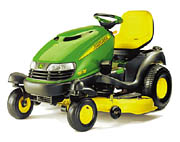 | Spin-Steer Technology™ Lawn Tractor by John
Deere, Horicon, Wis., and its industrial design firm, Henry
Dreyfuss Associates, Wood Ridge, N.J.
More high school kids may be flipping burgers this summer
rather than mowing lawns now that John Deere has managed to
create a lawn tractor that combines convenience with
unprecedented user-friendliness. The key ingredient?
Spin-Steer Technology.
“Homeowners needed a more maneuverable lawn tractor—a
vehicle that was as solid and user-friendly as a tractor while
at the same time providing the maneuverability of a zero-turn
machine,” explains Barry Goebert, advanced designer, John
Deere. “The Spin-Steer Technology (SST™) lawn tractors are the
first in the industry to offer zero-turning-radius
maneuverability and a steering wheel to provide the
traditional look and feel of a lawn tractor.”
Although traditional zero-turning-radius (ZTR) vehicles are
propelled using two separate hydraulic wheel motor systems,
one for each side of the vehicle, they operate independently
and can be difficult to manage.
“The solution was a differential steering transmission that
incorporates a propel transmission and a steering transmission
in the same case,” Goebert adds. “The two transmissions work
in unison to allow the rear wheels to rotate at different
speeds and to counter-rotate, allowing this vehicle to perform
a nonturf-damaging maneuver—a spin turn. The benefit is that
the efficiency of this new transmission is the same on each
side of the machine, thus making straight-line tracking much
better. It also provides full-time differential lock- and
power-steering, which are both unusual features for a tractor
of this size.”
However, controlling a differential steer transmission with
a steering wheel presented its own set of problems: When
backing up and turning the wheel to the left, the front of the
machine, not the rear, moved to the left. The solution is John
Deere’s reverse-logic system. The moment the operator’s foot
touches the reverse pedal, a vacuum-actuated system senses the
direction and switches the motion of the steering rods to
control the machine in the manner the operator expects. Thus,
backing up and turning the wheel left results in the rear of
the machine moving left. The system switches to forward
operation the instant the operator touches the forward pedal.
“The design is fantastic for this price level of lawn
tractor,” notes judge Jim Kaufman, professor, industrial
design, The Ohio State University. “It offers many design
features to help users operate and maintain the product for
years. The tractor represents very thoughtful design and
innovative engineering.”
Although John Deere’s designers thought long and hard about
usability, they did not neglect the tractor’s appearance.
Tests revealed operators were distracted by the front wheels
lack of movement. Thus, John Deere hid these wheels with
fenders for greater ease-of-use.
According to judge Carl Price, manager, industrial design,
Bose, the tractor’s forms suggest a race car more than a
tractor.
“The message in the styling of this tractor is consistent
with the rest of the design—it conveys the impression that
this is a fun, agile, and comfortable lawn tractor,” Goebert
adds.
Enhanced ergonomics are evident in the mower deck’s lifting
mechanism. Rather than requiring the operator to pull a heavy
handle or lever, the mower deck is lifted via a foot pedal.
Key project players from John Deere: Timothy Post, project
engineer; Wayne Hutchison, senior engineer; Barry Goebert,
advanced designer; Dave Marchese, engineer; John Blalock,
designer; Gene Hayes, senior engineer; Jim Swartzendruber,
advanced designer; Donald Ackley, senior product manager; Chad
Jennings, procurement engineer; Richard Teal, project manager;
Denny Docherty, manager, marketing, lawn & garden
products; Jim Hardzinski, sr. engineer, transmissions. From
Henry Dreyfuss Associates: Bengt Nestell, senior project
manager; Jeff Christian, project manager.
|
Commercial/Vending
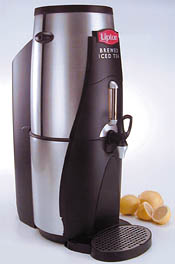 | Lipton Brewed Iced Tea Dispenser by IMI
Cornelius, Inc., Anoka, Minn., and Lipton’s industrial design
firm, Worrell Design Inc., Eden Prairie, Minn.
This sleek beverage dispenser is the result of a goal to
combine traditional cues, provocative aesthetics, and
time-saving operation in restaurant and self-serve iced tea
dispensing. Using Lipton’s extraction technology, the
appliance offers fresh tea on an as-needed basis with minimal
clean-up.
The product’s stainless appearance helps convey a sense of
cleanliness, while a sight glass reveals the beverage’s
appearance. To enhance the product’s impression of
ease-of-use, all technology is hidden inside.
“We made sure that lights, control panels, and buttons
would not confuse the customers, and confuse their impression
of the product,” Jeff Waffensmith, senior industrial designer,
Worrell Design, explains. “The detailing helps create the
image of a low-tech experience.”
Twice daily, the operator slides the upper door open to run
start-up and shut-down routines. The door is designed to
discourage access from consumers, and the control panel allows
the operator/service technician to run diagnostics, check the
number of hits, and run a cleaning cycle that propels a blast
of hot water through the system. However, the dispenser also
features a cap to promote the impression that the product is a
container, as well as handles to suggest the urn is lifted and
cleaned or refilled.
“The dispenser balances visual appeal with subtle,
sophisticated vertical forms,” notes judge Greg Montalbano,
principal, Montalbano Development. “The product has
leading-edge aesthetics while still possessing traditional
appeal through the judicious use of metalized detail.”
Disassembly is achieved with a minimum number of steps, and
assembly was streamlined. A structural foam bottom housing is
designed to act as a pallet accepting a fully assembled
internal brewing system. This allows the system to be secured
and tested before the cosmetic outer cladding is added.
“To reduce the reject rate and tooling cost, a
vacuum-formed coextruded laminate of ABS and Kynar was used to
simulate a high-polished stainless appearance,” Waffensmith
notes.
Key project players from IMI Cornelius Inc.: Brian Jones,
program manager; Russell Duchene, mechanical designer; Daniel
Ludovissie, project manager. From Pepsi/Lipton: Lars Woebcke,
marketing manager; Sanjay Kumar, equipment development
manager; Vincent Masotta, design manager, Lipton Creative
Resources. From Worrell Design: Jeff Waffensmith, senior
industrial designer; Matt Leyden, engineering manager; Thom
Tedham, design manager. |
Computers/Electronics
Communications
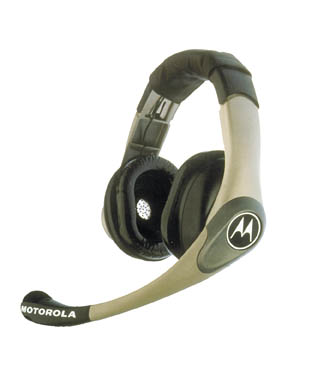 |
Motorola NFL Headset by Motorola, Schaumburg,
Ill., and its industrial design firm, Herbst LaZar Bell,
Chicago.
After becoming the official sponsor of the National
Football League (NFL), Motorola found itself with a tough
assignment: creating headsets that NFL coaches found
comfortable and effective while heightening consumer awareness
of the Motorola brand.
Developed in just four months in order to make the
nonflexible release date of the NFL season kick-off, the new
headset managed to draw attention to a formerly innocuous
element of games while meeting the needs of multiple users.
“The headset is an excellent example of advanced product
design and branding,” says judge Greg Montalbano.
To enhance the product’s appearance, the design team used
bold color contrast, high-impact logo placement, a new
profile, and a design that complements other Motorola-branded
products.
“Introducing such a new, dramatic look with such a
high-tech appeal into a tradition-bound atmosphere as football
was risky, but it paid off as this new design represents the
latest in wireless communication devices without ignoring the
mud and guts of professional football,” says John Hartman,
lead industrial designer/project manager, Herbst LaZar Bell.
To blend form with function, NFL coaches, players, and fans
evaluated the new design. Adjustability and “float” were built
into the headset wherever possible (ear cups, headband, boom)
in order to make the product as comfortable as possible. The
headset is bidirectional and may be worn on either side of the
head. Coaches may adjust the microphone piece, which is coated
with elastomer, making
it bend easily while standing up to rigorous use.
“This elegant design is placed in a rough environment and
makes a unique statement as far as corporate communications
for Motorola,” notes judge Jim Kaufman. “It’s a perfect blend
of branding and great product form.”
Robust parts are easily replaced and reconditioned while
all plastic components are recyclable.
Key project players from Motorola: Terry Taylor, manager,
industrial design;
Dan Williams, director, industrial design; Luigi Fiora,
lead engineer; Connie Kus,
engineering manager;
David Weisz, director, global sports & event marketing;
and Geoff Frost, vice president, global marketing/ media
relations. From Herbst LaZar Bell: John Hartman, lead
industrial designer/ project manager; Steve Remy, lead
mechanical engineer; Jason Billig, industrial designer; and
Elliott Hsu, industrial designer.
|
Floor Care
 | Multi-Surface Vacuum by Daewoo Electronics Co.,
Ltd., Korea, and its distributor, Tacony Corp., Fenton, Mo.
Creating a vacuum that combined the best of uprights,
canisters, stick vacs, and shop vacs was the impetus behind
the Multi-Surface Vacuum (MSV), which is available as the
Quick Silver (Simplicity) or the Riccar (Omni-Clean).
“The MSV incorporates an efficient straight-suction nozzle
for bare floor and carpet cleaning,” explains David Hamm,
director, R&D, Tacony Corp. “It has a turbo-nozzle option
for effective plush carpet cleaning. It also includes a
folding handle, shoulder strap, and rotating on-board tool
assembly with a removable telescopic wand for a wide variety
of above-floor cleaning configurations.”
“Being able to switch it from upright to an easily carried
canister vac is really great,” adds judge Carl Price. “It also
has nice features, like the cord retraction. Plus, it
collapses down for easy storage and offers multiple carry
positions.”
The handle grip was ergonomically weighted and formed so
that it rests comfortably in the hand with a low center of
gravity to reduce handle weight of the overall vacuum. The MSV
also incorporates a highly maneuverable pivoting nozzle that
reduces the forces and effort required to steer around
obstacles. The low weight of the system makes it easy to
carry. It can be lifted either with the handle extended, the
handle folded down, or the shoulder strap.
To effectively trap dust particles, the MSV utilizes a
four-stage filtration system with electrostatic filtration
media. By placing the electrostatic filter after the motor,
the filter media capture any remaining fine particles,
including carbon dust, from the motor.
To reduce part and tooling costs, the designers
incorporated small metal reinforcement plates under ABS
plastic components in high wear and stress areas rather than
using filled resins or larger metal parts. The motor for the
MSV is manufactured on an automated line, reducing the cost of
the most expensive component by 25 percent.
Key project players from Daewoo Electronics: Chang Woo Son,
general manager; Nam Ho Lee, manager; Sung Chul Park,
assistant manager; Jae Duk Lee, assistant manager. From Tacony
Corp.: John Kaido, president, Simplicity Vacuums; David Hamm,
director, R&D. |
HVAC
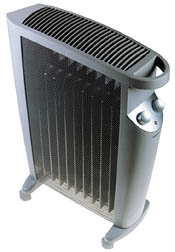 | Bionaire Convection Heater by The Holmes
Group/Bionaire, Milford, Mass., and its industrial design
firm, Herbst LaZar Bell, Chicago.
Carving a new niche in the HVAC market, the Bionaire
Convection Heater is a mobile, small room heater designed to
match the performance of oil-based radiator heaters without
the associated expense and danger.
“By using patented heating ‘fins’ in place of traditional
oil tanks, the design team was able to create a silent source
of heat for rooms up to 150-sq. ft.,” explains Anthony
Pannozzo director, industrial design, Herbst LaZar Bell. “The
technology can reach 175?F in just seven minutes. As it
operates, it stays cool to the touch. Its triple safety
protection features an auto safety shut-off, an over-heat
back-up fuse, and a wide track wheel base to ensure maximum
stability. Also, since the unit does not contain oil, there is
no danger of spills or leakage onto the floor.”
Judge Jim Kaufman adds, “It is a product that needs to be
as safe as it can be, which seems to be the case with this
product.”
In addition to safety, the heater was designed with form in
mind. A handle was integrated into the simple, racetrack
cross-section for easy maneuverability. The top was designed
with a crown to prevent the placement of objects that might
impair performance. Addition-ally, the controls were all
designed and spaced to be easy to use and intuitive for users
of all shapes and sizes.
Key project players from Bionaire: Heather Jones-Lawlor,
category director, household products; Paul Powers,
vice-president, houseware products. From Herbst LaZar Bell:
Anthony Pannozzo, director, industrial design.
|
Majors
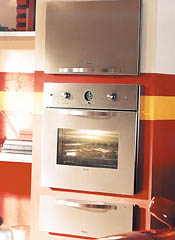 | Viking Designer Series Electric Single Oven by
Viking Range Corp., Greenwood, Miss.
The Electric Single Oven is a member of Viking’s new
Designer Series, which features a contemporary look as well as
the quality and performance characteristics of Viking’s
“Professional” line of appliances.
“Although the unit is built on the Viking ‘Professional’
oven chassis, the ‘Designer’ oven takes on a whole new
personality,” explains Brent Bailey, industrial design
manager, Viking Range Corp. “All ventilation was removed from
the front fascia and moved to the perimeter to give a sleeker,
non-cluttered look.”
Additionally, the handle is constructed from
investment-cast stainless steel with a brushed front surface
to match the door surface. All other knobs and buttons are
cast stainless steel, offering the product a monochromatic
look and substantial feel.
“This product design achieves a high level of aesthetic
appeal, which it deserves at this high-end market,” notes
judge Jim Kaufman. “The design is very consistent throughout
the entire product line. Each product in the line was
carefully planned to complement the others.
An exclusive feature is the clock/timing device, which
incorporates fully synchronized analog and digital features.
While the oven is at rest, only the analog clock display is
shown. Digital functions appear out of the black analog fascia
when activated and are used for timing functions. By setting
the time digitally, the analog calibrates itself.
Market research indicated that consumers preferred
manual/analog controls rather than analog in regard to oven
function and temperature setting. The handle was designed
using anthropometrical data, while the high-temperature
silicon rubber grip area provides a nonslip surface and
comfort.
“We feel this feature’s design helps convey the
jewelry-like, high-end appearance necessary for the Designer
Series,” notes Bailey.
Key project players from Viking Range Corp.: Robert
Mcbryde, senior product manager; Brent Bailey, industrial
design manager; Mike Sparks, mechanical engineer; and Mark
Finke, industrial engineer.
|
Portable Power Tools
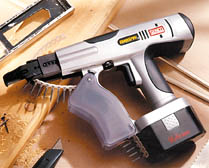 | DuraSpin Screw Fastening System by Senco,
Cincinnati, Ohio, and its industrial design firm, Joss Design
Group, Chicago.
A gotta-have-it power tool for home improvement
enthusiasts, the DuraSpin Screw Fastening System aims to ease
heavy, screw-related tasks in a dynamic, robust package.
The adjustable nose piece features legible length markings
that adjust to screw lengths from 1 to 2 in. With its pop-in
and pop-out quick-bit release system, no chuck is necessary.
The 2,300-rpm high-torque motor is designed to drive screws
without bogging down, while the 14.4 V battery provides
optimum power and run-time across the full range of screws.
“Ergonomics were a key driver in the development of the
design,” explains John Van Akkeren, vice president, product
development, Joss Design Group. “The tool is carefully
balanced to optimize user comfort and reduce repetitive
strain. The comfort grip and cushioned trigger were designed
for better productivity. The clutch design extends motor and
bit life by disengaging when the drive is completed, and the
second hand grip is designed to combat worker fatigue.”
Safety was also a design goal, as the screw guard design
protects hands and clothing.
Key project players from Senco: Gary Bohar, product
manager; Tom Day, marketing manager. From Joss Design Group:
Steve Cozzolino, designer; Paul King, designer; John Van
Akkeren, vice president, product development/designer.
|
Medical Appliances/Laboratory
Equipment
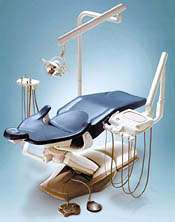 | Midmark Dental Chair and Light by Midmark
Corp., Versailles, Ohio, and its industrial design firm, Big
Design, Atlanta.
With its emphasis on patient comfort, the Midmark Dental
Chair and Light may be just the solution to anxiety-ridden
dental visits.
In addition to improving the physical and psychological
comfort of patients, the design team at Big Design aimed to
improve the manufacturability and serviceability of all
components while improving light quality, user interface, and
overall system operability.
To improve patient comfort, multiple durometer (hardness)
foams were used in the seat cushion, and the armrests were
placed on the back of the seat rather than the base, thereby
easing shoulder strain and eliminating interference problems
during chair entry or exit.
To reduce patient anxiety, the designers employed an
elegant, contemporary product shape and appearance.
Additionally, they eliminated clinical materials and shapes
such as exposed fasteners, connectors, and parabolic light
fixtures. Lastly, they used a hydraulic, rather than
screw-type, actuation system, eliminating noise and enabling
smooth, precise chair movement.
“The seat looks sensual and inviting,” notes judge Carl
Price. “Without having ever sat in it, it appears to be
comfortable and supportive. I think they did a great job at
creating a seat that decreases patient anxiety.”
To reduce part count, large castings, rather than metal
fabrication, were employed, in addition to injection molding,
rather than pressure- and vacuum-forming.
“It will be fun to go to the dentist with this equipment,”
judge Jim Kaufman adds.
Key project players from Midmark Corp: Bill Zulauf, product
manager, dental division; marketing, design, engineering, and
manufacturing teams. From Big Design: Steven Meister, vice
president, marketing; industrial design, mechanical
engineering, and 3D modeling teams.
|
Portable Appliances/Personal
Care
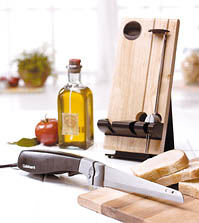 | Electric Knife - Model CEK-40 by Cuisinart,
Stamford, Conn., and its industrial design firm, Ecco Design,
New York, N.Y.
The staid electric knife has seen little innovation since
its inception, making it just the kind of product Cuisinart
hoped to improve. After conducting market research and
benchmarking the existing assortment of electric knives, the
design team created the CEK-40 for the high-end consumer
market.
“There is no new technology in the makeup of the
components, but the innovation is in the concept and the knife
holder,” says Kerry Cooper, senior marketing manager,
Cuisinart. “The knife itself was made to be rugged and
durable, and the materials produced a matte finish to
replicate the finish of expensive kitchen knives.”
The product features two blades: one for carving, one for
slicing bread. They are secured safely in the stand by a
spring-loaded catch, while the knife is secured by an inlet
groove for the tip and a press-fit on the strain relief at the
base of the stand. Cord storage is offered around the flexible
foot at the base of the stand. The foot allows the stand,
which is made of hard wood, to lie flat in a drawer or rest on
a counter.
“It looks like the grip is comfortable and safe,” adds
judge Jim Kaufman. “It is easy to clean and store.”
Judge Greg Montalbano adds, “It’s an excellent combination
of quality design, color, texture, and finishing details.”
Key product players from Cuisinart: Barry Haber, senior
vice president; Paul Ackels, group vice president, marketing;
Jill Orent, director, marketing; Kerry Cooper, senior
marketing manager; Barbara Schnabel, marketing manager; Art
Sansone, vice president, engineering; Asik Braginsky, lab
technician. From Ecco Design: Jeff Miller, vice president,
design. |
Test, Measurement, Inspection
Equipment
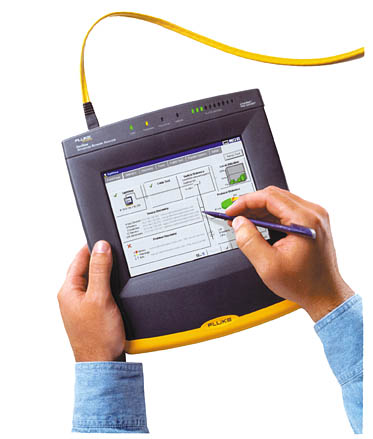 |
Fluke Networks OptiView™ Integrated Network
Analyzer by Fluke Networks, Inc., Everett, Wash.
With its multiple diagnostic tools, the OptiView Network
Analyzer required power, flexibility, and durability in order
to execute its many functions. Additionally, it had to adapt
to various environments, from the office desktop to the wiring
closet and from open, well-lit areas, to dark, compact spaces.
“The design combines a Pentium processor, running Microsoft
Windows, using a touchscreen for the interface, with
state-of-the-art network test and monitoring hardware,”
explains Wayne Hoofnagle, senior industrial designer, Fluke
Networks, Inc. “It provides the power of a rack-mounted system
with the portability of a laptop, all in a rugged package. Add
this to the ability to swap-out the test hardware board and
you have the flexibility to upgrade and enhance the product in
minutes.”
Based on customer feedback, the design team used a
rectilinear, flat form for portability. The desk tilt-stand
angle was optimized for the standard office desk surface. The
use of color—the gray body with the yellow
over-mold—complements traditional Fluke test products.
“Fluke has done it again,” judge Carl Price says. “They
have the amazing ability to introduce new products which
continue to support the Fluke image while moving it forward.
Everything they make looks easy to use and friendly while at
the same time saying ‘precision, high-tech equipment.’”
Judge Greg Montalbano adds that the intuitive touchscreen
interface eases information navigation, while the clean design
implies ruggedness and quality.
Serviceability was enhanced through the design of an
interchangeable hardware test board, making repair or
replacement simple. Other components are readily accessible
once the case is opened. The display is modular and easily
removed, while the tilt-stand is designed to pop off if
overextended, preventing breakage.
As the complexity of the instrument renders assembly
challenging, the design team included built-in test points in
the hardware test boards and PC board to allow full
diagnostics during assembly. The main case components assemble
in the Z axis with the test hardware board module inserted
last. Additionally, the overmold is easily manufacturable with
little cost or size penalty to the product. The LED lenses are
in-molded in the module, eliminating an assembly step and
increasing part reliability.
Key project players from Fluke Networks, Inc.: Wayne
Hoofnagle, senior industrial designer; Roger Howell, senior
mechanical engineer; Tom Resman, project manager; Frank Actis,
product planner; Paul Swanson, electrical engineer; Stan
Bowlin, electrical engineer.
|
Electrical Fitness
Equipment
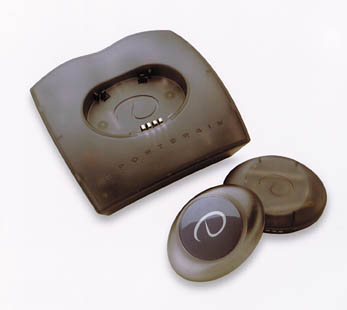 |
SportBrain Personal Fitness Assistant by Sport
Brain Inc., Sunnyvale, Calif., and its industrial design
firms, Stratos Product Development LLC, Seattle, and Lucente
Design, San Francisco, Calif.
If tracking stock performance has lost its appeal, the
personal fitness assistant offers an alternative. The tiny
device records the user’s physical movement and downloads the
data to a personal Web page where the user can track, share,
and compare progress with others.
“The SportBrain tracker is a truly groundbreaking
concept—users just wear it—there are no buttons to press and
nothing to configure,” says Deane Gardner, co-founder &
chief technology officer, SportBrain. “Users simply place it
onto their belt or waistband and the tracker monitors all
their activity over the course of a day.”
Users connect the accompanying SportPort to a regular phone
line. At the end of the day, users place the SportBrain
tracker into the SportPort where a dial-up number is
automatically dialed and the information is sent to the
SportBrain Web servers in 60 seconds. Users see all their
information on their personalized Web pages, which offer
detailed information and graphics on all their activity.
“The product possesses a soft, unobtrusive, minimalist
aesthetic that is very appealing,” notes judge Greg
Montalbano. “I like the fact that the user interface is
web-based, allowing the product to remain clutter-free.”
The small size of the product, high use of injection-molded
plastics, along with the use of sheet metal/stampings render
the manufacturing and assembly processes simple. The lack of
display and buttons minimizes manufacturing costs and keeps
reject rates low.
“It makes working out and tracking improvements simple to
do,” adds judge Carl Price. “I can see how this would
be appealing to people intimidated by technology.”
Key project players from SportBrain: Deane Gardner,
co-founder, chief technology officer; Michelle Hickford,
co-founder, chief marketing officer. From Stratos Product
Development LLC: John Harvard, analog engineer; Brent LaPorte,
digital engineer; Mike Nelson, industrial designer; Macen
Shinsato, project manager. From Lucente Design: Sam Lucente,
principal. |
Peripherals/Accessories
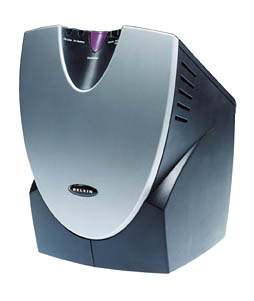 | Belkin Regulator Pro Gold UPS by Belkin,
Compton, Calif., and its industrial design firm, Hauser, Inc.,
Westlake Village, Calif.
Preventing the loss of valuable PC data, the
uninterruptible power supply (UPS) ensures consistent power to
computers, while its battery allows for up to 30 minutes of
backup time in case of a power outage. The USB interface and
software automatically saves data and shuts down the computer
in the event of a power outage.
The primary design objective for the Belkin Regulator Pro
Gold UPS was to provide the largest possible surface area to
accommodate eight plugs—even bulky transformer “bricks”—while
keeping the entire package and footprint as small as possible.
Other challenges included managing up to eight power cords,
designing the status indicator lights and on/off button to be
accessible, making it easy to manufacture, and creating a
physically appealing product.
The sloped surface allows for a large outlet area, and the
angle makes it easy to insert plugs. The integrated, flexible
cable corral keeps the power cords directed toward the rear of
the unit. The indicator lights are centrally located and wrap
around the top edge, making them easy to see from all angles.
The on/off /test button is also centrally located and on the
top edge for easy access, while being flush mounted in the
recessed scoop to avoid accidental actuation. The battery is
easily accessed from a lower rear door.
“The silver parabolic shield-like form on the face of the
unit was designed to evoke a sense of protection, security,
and power,” adds Rob Curedale, project manager, Hauser, Inc.
“When viewed from other angles, the profile and cuts into the
form are dynamic, symbolizing the constant activity of the
power conditioning.”
According to judge Carl Price, the Belkin Regulator Pro
Gold UPS is one of the few UPS products he would be willing to
leave in plain sight.
“Wire management is incorporated, which most similar
products ignore,” judge Carl Price adds. “The UPS is small and
compact with outlets easily accessible.”
Key project players from Belkin: Ernesto Quinteros,
director, industrial design. From Hauser, Inc.: Rob Curedale,
project manager; Kenneth Mori, lead industrial designer;
Oliver Duncan Seil, industrial designer; Mark Westcott,
mechanical engineer. |
Charmaine is assistant editor of Appliance Design
Magazine. She can be reached at 440/349-3060 x208.
E-mail Charmaine at: am2edit@nowonline.net
|
To
obtain FREE information about the products and companies mentioned
in this article, please use our Webcard.
|

